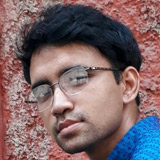Unique heritage walks: Destination Serampore Radhaballav and Madanmohun temples
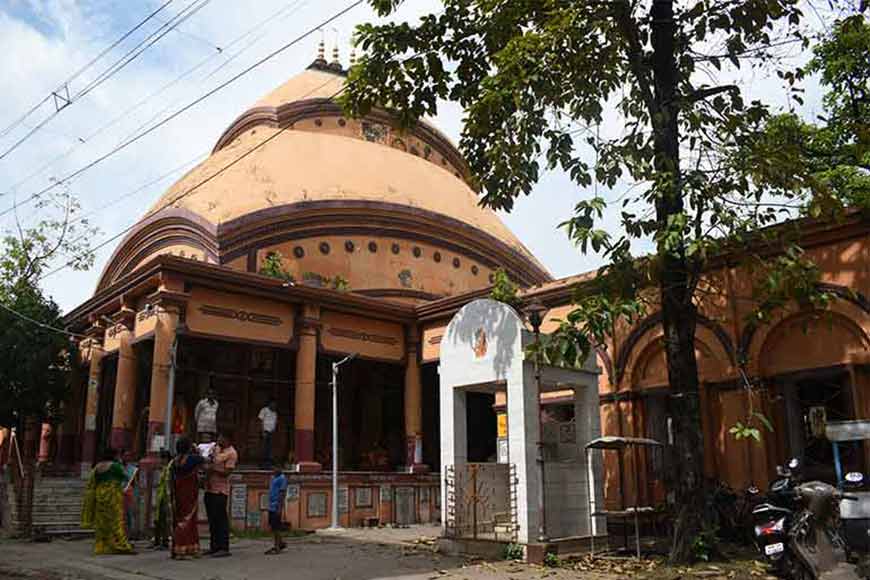
Radhaballav temple
On our heritage trail in Serampore, our second destination was the historic Radhaballav Temple, located on Ballavpur Thakurbati Street. This temple was built in 1764 by the devout Vaishnavite Zamindar, Nayan Chand Mullick, the scion of the affluent Mallick family of Pathuriaghata Street in North Kolkata. In 1837, his son, Nimai Charan Mullick arranged for the ‘Nitya Seva’ (daily service) of the deities. This temple is one of the largest ‘Aatchala’ shrines of Bengal. Aatchala is a typical Bengal temple architecture style which has triple entrances giving onto a porch. The roof can either be straight-edged pyramidal or rounded.
The history of the present-day Radhaballav temple is very interesting. Rudraram Pundit originally built a temple and established the idol of Radhaballav Jiu. His maternal uncles lived in the vicinity of Serampore at Chatra. The ‘Dol-Mancha’ of the present Radhaballav temple is built exactly the way it was erected by Rudraram at Chatra. The original ‘Aaatchala’ Dol-Mancha lies deserted in a dilapidated state near the temple. On close scrutiny, traces of beautiful designs can still be seen on the ruined walls of the ‘Aaatchala.
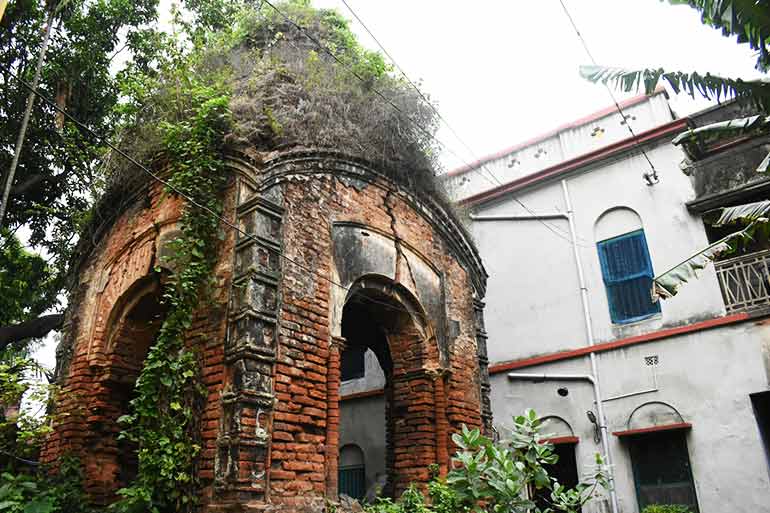 Dol Mancha
Dol Mancha
According to popular belief, Lord Krishna appeared in Rudraram Pundit’s dream and instructed him to fetch a specific stone from the palace of the Sultan of Gaur and get an idol sculpted. Rudraram followed the instruction and went to fetch the stone from the palace. When he reached his destination, he was astonished to witness the divine manifestation of Lord Krishna. It is said that the stone ‘sweated’ profusely in the heat and the Lord appeared in Rudraram’s dream again and instructed him to immerse the stone in the nearby river. It was a large ‘Kashti-pathor’ (touchstone) that he later retrieved from the river and commissioned a sculptor from Vrindavan to carve Lord Krishna’s idol. The artist engraved three deities from the stone and Radhaballav Jiu’s idol at Serampore is one of them.
An ‘Aatchala’ Radhaballav Temple was built on the banks of Ganga River around 1677 by Rudraram with the assistance of other disciples. Later, as the river changed its course, the temple was damaged in the large-scale land erosion that followed. Devotees stopped visiting the site that was prone to accident and soon, the place was vacated. The deity was shifted from the ancient temple and re-established in the newly-built temple in 1764. The desolate, discarded temple was later transformed into a church by evangelical minister, Rev. Henry Martyn. The site has been refurbished with government aid and is now well-known as Henry Martyn Pagoda.
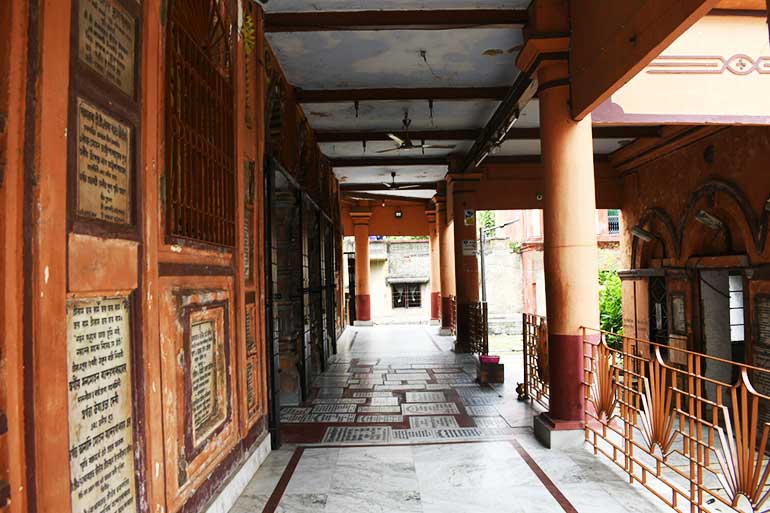
Since ancient times, Radhaballav Jiu was worshipped in Serampore and the locality came to be known as Ballavpur. Other than the ‘Nitya Seva’ offered to the Lord at the temple, festivals galore throughout the year and the temple is decorated aesthetically during these fests. These elaborate festivals include Phool Dol (playing Holi with flower petals), Snan Yatra (Bathing festival), Raash, Gostha, Jhulan, Virat Utsav and Maghi Purnima.
The present ‘Nat-mandir’ (it is the front open building of the temple) of Radhaballav Jiu temple was constructed by Mahim Chandra Dutta. His father Mahesh Chandra Dutta opened a confectionary shop a little away from the temple by the side of the Ganga. That was almost 200 years ago. According to popular lore, once Radhaballav Jiu visited the sweetmeat shop in the disguise of a young lad and had Gutke Sandesh to his heart’s content. But since he did not have cash to pay the owner, he opened a gold bangle from his wrist and insisted Mahesh Chandra to keep it until his father paid his dues. Later, there was an uproar in the temple as the priest discovered one of the gold bangles that adorned the idol of Sri Radhaballav Jiu was missing. When Mahesh Chandra heard this, he rushed to the temple and to the shock of everyone, the mystery of the missing bangle came to light. Since then, the fame of Gutke Sandhesh reached above and beyond the borders of Serampore.
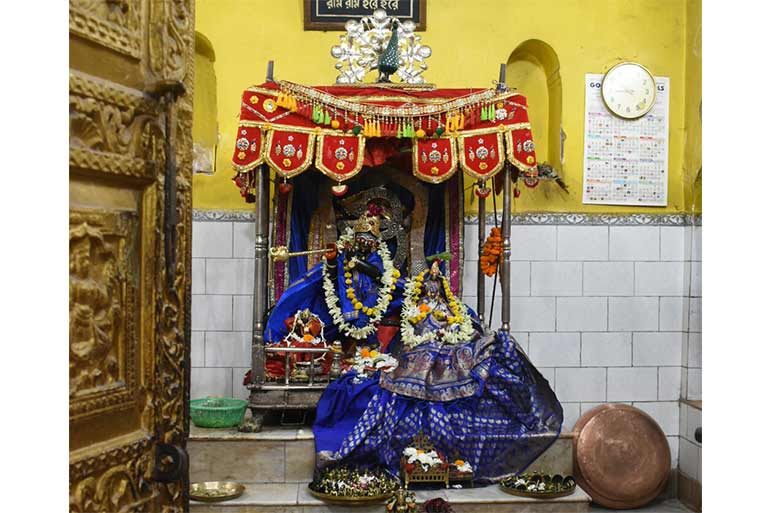 Radhaballav Jiu’s idol
Radhaballav Jiu’s idol
Located in the vicinity of the Radhaballav Jiu’s temple, there is another ancient temple at Akna Chowdhury Para, the Madan Mohun Temple. The site where the temple is located was once inhabited by Ramanuj Vaishnavas who hailed from South India. In the middle of the 19th century, they built the temple and started offering prayers to Lord Madan Mohun. They also raised an ‘akhara’ (a monastery for religious renunciates in Guru–shishya tradition) there. But they suddenly left the land and went away. The place remained unoccupied for a long time and Mother Nature reclaimed the land. Dense jungle sprang up in the vacant plot. Later, when the Danish rulers were scouting for a suitable plot to set up a hospital, they came across the plot and discovered the idol of Madan Mohun Jiu there. Gopal Chandra Mukhopadhyay, a local Hindu worked under the Danish government and the representatives of the Crown handed over the responsibility of the deity to Mukhopadhyay. The Danish government promised to bear the daily expenses of the ‘Nitya Puja.’ Finally, in 1845, when Denmark sold Serampore to the British and left, Mukhopadhyay was paid a one-time lumpsum amount for the upkeep of the temple. With that money, he constructed the present Madan Mohun Temple. Even to this day, the responsibility of the daily puja is shouldered by turns by ’Paladars.’ The temple ground is always bustling with activities as myriad festivals are celebrated round the year similar to the ones at Radhaballav Jiu’s temple. Devotees throng in large numbers to attend these festivals. During Raas celebration, Madan Mohun Dev is taken out of the sanctum sanctorum and carried on shoulders for a trip around the town. On this day the Lord knock at the homes of His devotees and accepts ‘Prasad’ (a devotional offering made to God) offered to Him personally!
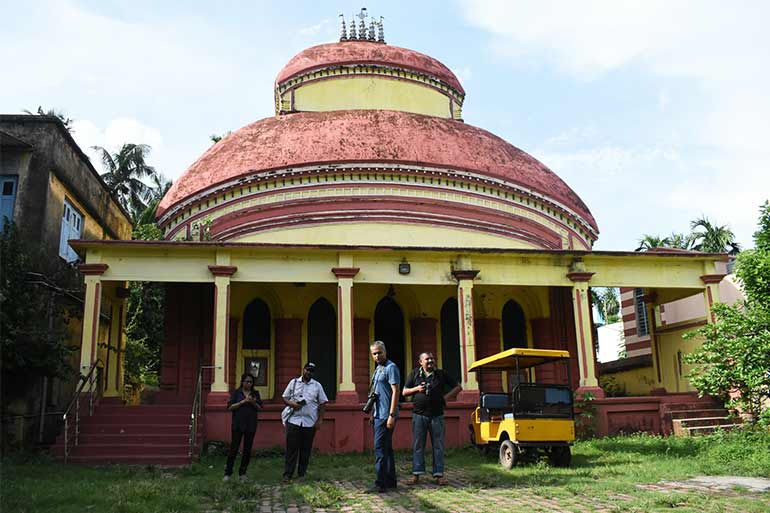 Madan Mohun Temple
Madan Mohun Temple
Next to the Madan Mohun Temple is the famous ‘Thakurdalan’ (Thakurdalan is a specious structure built up inside the temple) of the Chowdhury family. During the family’s heydays, Durga Puja was celebrated with much pomp in the thakurdalan. The puja ushered in days of festivities which included, among other including night-long Jatra (a popular folk theatre) performances, Pala gaan et al. Anthony Firingee (Anthony the foreigner) aka Hensman Anthony (1786–1836), who mesmerized audience with his mellifluous renditions of Bengali devotional songs, was a regular at the venue. He was also noted for his performance in literary face-offs known as Kabigaan. Steeped in tradition and history, these ancient localities of Serampore struggle to survive amid the decadence that marks this fast-paced 21st century.
(Translated by Tales, Talks & Walks)






